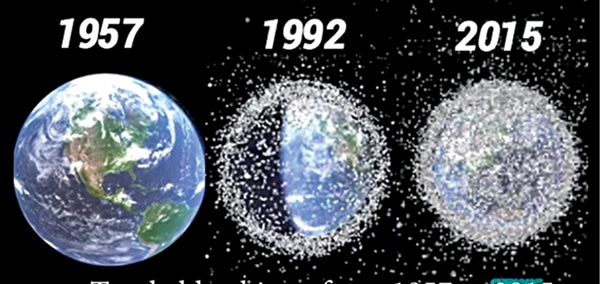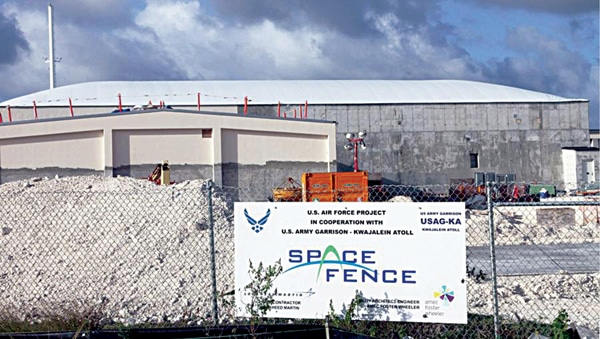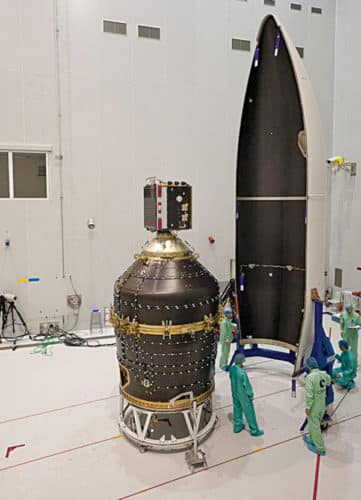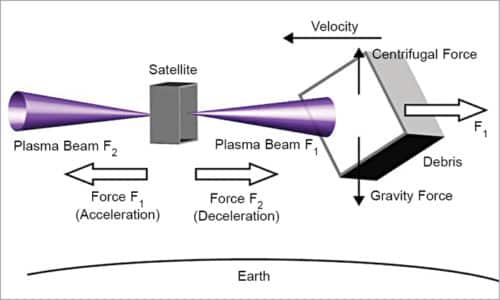Consequent to increase in number of artificial objects orbiting Earth, collision hazards have become more probable. Spacecraft enabling communication, navigation, scientific, and other missions now share Earth orbit with spent rocket bodies, nonfunctional spacecraft, fragments from spacecraft breakups, and other debris created as a byproduct of space operations. Millions of tiny pieces of junk orbiting the Earth could have a major impact on space. Orbital debris removal has become a very critical part of the commercial and scientific space management. It is an aggregating risk which needs to be addressed to prevent loss of spacecraft to debris collision. This article aims to create awareness about this risk. Innovative techniques have been proposed to solve the problem.
From almost the first moment that man started traveling beyond Earth’s atmosphere, all sorts of debris in space has been left. Not only is it wasteful, space junk can be dangerous to satellites, to space stations, and when some of it plummets back to Earth, to human life on the ground.
Two years ago, an 18-ton Chinese rocket plummeted toward Earth and landed in the Atlantic Ocean, becoming one of the largest pieces of space debris to fall uncontrolled back to Earth in recent times. The Times of India in their issue dated 11th April 2022 reported that India alone has 103 active or defunct spacecraft and 114 objects categorised as space debris.

Such space debris is composed of spent boost stages, collision fragments. human discards, inactive or defunct satellites, rocket bodies, ISS construction material, and other parts of spacecraft that have been left behind.
Some space junk results from collisions or anti-satellite tests in orbit. When two satellites collide, they can smash apart into thousands of new pieces, creating lots of new debris. This is rare, but several countries including the US, China, and India have used missiles to practice blowing up their own satellites.
There are estimated to be over 128 million pieces of debris smaller than one centimetre. There are approximately 900,000 pieces from one to ten centimetre in size. The current count of large debris (10cm across or larger) is 34,000.
Space debris is mostly concentrated in the near-Earth space region, in the Low Earth Orbit (LEO) and Geostationary Earth Orbit (GEO) regions. Low Earth Orbit is defined as the region of space around Earth within an altitude of 160 to 2000km wherein a large number of active satellites operate. This causes a substantial operational risk, ranging from the need to perform evasive maneuvers to defects or even obliteration of spacecraft due to collisions with pieces of debris, which at orbital speeds of approximately 7.5km/s can cause considerable damage.
NASA estimates that currently there are some 21,000 pieces of space junk larger than a softball orbiting the Earth that can damage a satellite or spacecraft. According to experts, the problem will get worse. By 2025 as many as 1100 satellites could be launching each year. The number of satellites orbiting Earth is projected to quintuple over the next decade.
The estimated 8800 tons of objects that humans have left in space are becoming a danger. Near misses are common these days. In September 2019, there was one near miss between Elon Musk’s SpaceX satellite and one from the European Space Agency.

But so far, there has been just one major collision. In 2009, American satellite Iridium 33 and Cosmos 2251, a Russian satellite, crashed, destroying both over northern Siberia. In January 2020, a satellite run by AT&T’s DirecTV was found to be in danger of exploding and needed to be moved, or else it could harm other satellites.
In April 2020, the FCC of USA voted to require more disclosures from satellite operators seeking licenses but declined to introduce any new laws governing the removal of orbital debris. Space debris is emerging one of the main threats for an affordable and safe space exploration and exploitation.
Background
One may ask, “What is orbital debris?” Though one doesn’t see space junk in the sky, beyond the clouds and further than the eye can see, it enters Low Earth Orbit (LEO), which has become an orbital space junk yard. There are millions of pieces of space junk flying in LEO. Most orbital debris comprises human-generated objects, such as pieces of spacecraft, tiny flecks of paint from a spacecraft, parts of rockets, satellites that are no longer working, or explosions of objects in orbit flying around in space at high speeds.
Most space junk is moving very fast and can reach speeds of 28,000km per hour, almost seven times faster than a bullet. Due to the rate of speed and volume of debris in LEO, current and future space based services, explorations, and operations pose a safety risk to people and property in space and on Earth.
There are no international space laws to clean up debris in LEO. It’s very expensive to remove space debris. The NASA Orbital Debris Program officially began in 1979 in the Space Sciences Branch at the Johnson Space Center (JSC) in Houston, Texas. The program looks for ways to create less orbital debris, and designs equipment to track and remove the debris already in space.

In coming years, the number of satellites will increase by an order of magnitude, with multiple mega-constellations made up of hundreds or even thousands of satellites planned for LEO to deliver wide-coverage, low-latency telecommunications, and monitoring services. Space junk is no one country’s responsibility, but the responsibility of every space-faring country. The space around our planet is filled with rubbish. It’s time to take out the trash!
Innovative strategies
Lockheed Martin announced the construction of a Space Fence on the Marshall Islands in the central Pacific Ocean to track and identify space objects. Astroscale, a private company in Japan, whose mission is to clean up such space debris, is leading the charge to clean up our space pathways. The Japanese company is currently working with Japan’s Aerospace Exploration Agency (JAXA) to carry out the agency’s Commercial Removal of Debris Demonstration (CRD2) project.
The JAXA mission plans to complete its first phase by the end of 2022. The goal of the mission is to launch a satellite that will observe and acquire data on the rocket upper stage that the second phase will seek to deorbit. The idea is to find out how the debris moves in space and set up a safe and successful removal.
Northrop Grumman launched its first Mission Extension Vehicle spacecraft (MEV-1) in 2019 to prove it could intercept falling satellites, remove them from traffic, repair them, and put them back in orbit. Swiss start-up ClearSpace, meanwhile, has a more specific goal to remove a 100kg Vega Secondary Payload Adapter (Vespa) upper-stage rocket orbiting around 645km (400 miles) above Earth.
It plans to do that in 2025. The ClearSpace-1 ‘chaser’ will be launched into a lower 500km orbit for commissioning and critical tests before being raised to the target orbit for rendezvous and capture using a quartet of robotic arms under ESA supervision. The combined chaser plus Vespa will then be deorbited to burn up in the atmosphere.
According to Dr Holger Krag, head of the Space Safety Program Office at the European Space Agency, the agency is looking into using lasers to gently push the objects off the path. Chris Blackerby, Group COO and Director, Japan for Astroscale said, “I think the idea that space debris is an active threat to our current satellite population is becoming more widely accepted.”
NASA scientist Donald Kessler asserted that an exploding chain of space debris can make exploring space and the use of satellites impossible for generations. The fear is that we get to a level of unsustainability of orbit.
An active debris removal mission, if successful, has a positive effect (risk reduction) for all satellites in the same orbital band. This may lead to a dilemma: each stakeholder has an incentive to delay its actions and wait for others to respond. This makes the space debris removal an interesting strategic dilemma. As all actors share the same environment, actions by one have a potential immediate and future impact on all others. This gives rise to a social dilemma in which the benefits of individual investment are shared by all while the costs are not.
To counter this risk, mitigation strategies are now implemented in newly launched satellites.
Following a competitive process, a consortium led by Swiss startup ClearSpace—a spin-off company established by an experienced team of space debris researchers based at Ecole Polytechnique Fédérale de Lausanne (EPFL) research institute—submitted their final proposal.
“This is the right time for such a mission,” says Luc Piguet, founder and CEO of ClearSpace. “The space debris issue is more pressing than ever before. Today we have nearly 2000 live satellites in space and more than 3000 failed ones.
“The need is clear for a ‘tow truck’ to remove failed satellites from this highly trafficked region.”
At Space19+, which took place in Seville, Spain, ESA’s Ministerial Council agreed to place a service contract with a commercial provider for the safe removal of an inactive ESA-owned object from LEO. Supported within ESA’s new Space Safety program, the aim is to contribute actively to cleaning up space, while also demonstrating the technologies needed for debris removal.
“Even if all space launches were halted tomorrow, projections show that the overall orbital debris population will continue to grow, as collisions between items generate fresh debris in a cascade effect,” says Luisa Innocenti, heading ESA’s Clean Space initiative. “We need to develop technologies to avoid creating new debris and removing the debris already up there.”
NASA and ESA studies show that the only way to stabilise the orbital environment is to actively remove large debris items. The ClearSpace-1 mission will target the Vespa (Vega Secondary Payload Adapter) upper stage left in an approximately 800km by 660km altitude orbit after the second flight of ESA’s Vega launcher back in 2013. With a mass of 100kg, the Vespa is close in size to a small satellite, while its relatively simple shape and sturdy construction make it a suitable first goal, before progressing to larger, more challenging captures by follow-up missions—eventually including multi-object capture.
Other novel concepts
There are many possible means of reducing the debris hazard to future space operations. There is no shortage of concepts for cleaning up the junk we have left behind in orbit, even if some of them seem far-fetched. Here’s an overview of some of the ideas being proposed for cleaning up space debris.

Fig. 4 illustrates a novel concept for space debris removal by bi-directional momentum ejection from a satellite. When plasmas carrying momentum fluxes F1 and F2 are expelled from two axially opposite satellite exits, the respective forces shown by the horizontal arrows F1 (pointing to the left and providing the acceleration of the satellite with respect to the orbit velocity) and F2 (providing the deceleration) are generated and used to adjust the satellite velocity relative to the debris. Continuously imparting momentum flux F1 to the debris (horizontal arrow F1 pointing to the right) will cause its deceleration, final re-entry into the Earth atmosphere and natural burn up.
Recycling satellites
Instead of just trashing space debris, some dead satellites could be ‘mined’ by other satellites for useable components. DARPA’s Phoenix plan could create new technology to enable harvesting of some valuable components from satellites in so-called ‘graveyard’ orbits. The plan would work to devise nano-satellites that would be cheaper to launch and could essentially complete their own construction by latching onto an existing satellite in the graveyard orbit and using the parts it needs.
Space garbage trucks
The US Defense Advanced Research Project Agency (DARPA) is investing in the Electrodynamic Debris Eliminator, or EDDE, a space ‘garbage truck’ equipped with 200 giant nets, which could be extended out to scoop up space garbage. The EDDE could then either fling the garbage back to Earth to land in the oceans, or push the objects into a closer orbit, which would keep them out of the way of current satellites until they decay and fall back to Earth.
Self-destructing janitor satellites
Swiss researchers at the Federal Institute of Technology have devised a small satellite, called CleanSpace One, which could find and then grab onto space junk with jellyfish-like tentacles. The device would then plummet back towards Earth, where both the satellite and the space debris would be destroyed by the heat and friction of re-entry.
Giant lasers
Using high-powered pulsed lasers based on Earth to focus plasma jets on space debris could cause them to slow down slightly and to then re-enter and either burn up in the atmosphere or fall into the oceans. “The method is called Laser Orbital Debris Removal (LODR) and it wouldn’t require new technology to be developed—it would use laser technology that has been around for 15 years. It would be relatively cheap, and readily available.” The biggest hitch, other than adding more litter to the oceans, is the estimated $1 million per object price tag.
Space balloons
The Gossamer Orbit Lowering Device, or GOLD system, uses an ultra-thin balloon (thinner than a plastic sandwich bag), which is inflated with gas to the size of a football field and then attached to large pieces of space debris. The GOLD balloon will increase the drag of objects enough so that the space junk will enter the earth’s atmosphere and burn up. If the system works, it could speed up the re-entry of some objects from a couple of hundred years to just a few months.
Wall of water
Another idea for cleaning up space junk, from James Hollopeter of GIT Satellite, is to launch rockets full of water into space. The rockets would release their payload to create a wall of water that orbiting junk would bump into, slow down, and fall out of orbit. The Ballistic Orbital Removal System is said to be able to be put into action inexpensively, by launching water on decommissioned missiles.
Space pods
Russia’s space corporation, Energia, is planning to build a space pod to knock junk out of orbit and back down to Earth. The pod is said to use a nuclear power core to keep it fueled for about 15 years as it orbits the earth, knocking defunct satellites out of orbit. The debris would either burn up in the atmosphere or drop into the ocean. It is claimed to clean up the space around Earth in just ten years, by collecting around 600 dead satellites (all on the same geosynchronous orbit) and them sinking them into the ocean.
Sticky booms
Altius Space Machines is currently developing a robotic arm system it calls a ‘sticky boom,’ which can extend up to 100 metres, and uses electro-adhesion to induce electrostatic charges onto any material (metal, plastics, glass, even asteroids) it comes into contact with, and then clamp onto the object because of the difference in charges. The sticky boom can attach to any space object, even if it was not designed to be handled by a robotic arm. The sticky boom could be used to latch onto space debris for disposal.
Dr Ranjit Singh, FIETE, is with Department of Electronics Communication Engineering, Ajay Kumar Garg Engineering College, Adhyatmic Nagar, Ghaziabad, UP






